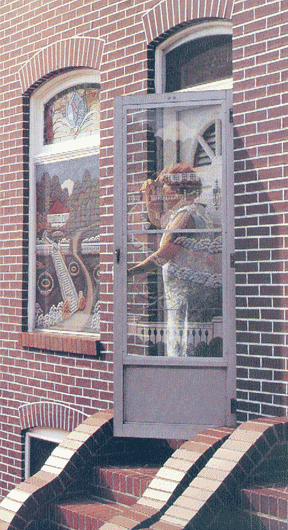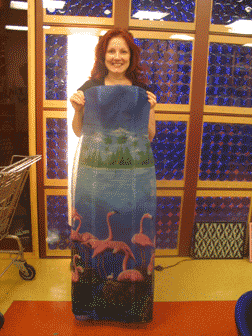|
|||||||||
Rowhouse RembrandtsBaltimore’s screen painting is more than just window dressingby Diana Beechener, Bay Weekly staff writer
Pat Michalski’s canvas is a three-foot window screen. She demonstrates how to streak golden sunlight highlights on a clump of sea grass sprouting from sand, then hands the brush back to her student. The next screen she visits shows a scarecrow. Making the rounds at Glen Burnie’s Pascal Senior Center, where her students are all amateurs, Michalski next offers advice on how to paint out a wayward butterfly on a floral screen. Screen painters “do not have to have any God-given talent,” Michalski says. “Students need not be intimidated by that.” Michalski and her screen painting peers plan on taking that message to May’s three-day Rowhouse Rembrandts festival, where aging artists hope to pass East Baltimore’s historic art of screen painting to a new generation. Behind the ScreensAsk a screen painter, and you’ll hear that East Baltimore’s most recognizable art form was born from rotted fruit. During an especially muggy summer in 1913, grocer William Anton Oktavec found that his fruit spoiled sitting in the direct sunlight of his store’s bay windows. Armed with a paintbrush and an idea, the grocer found a way to fight the sun and advertise his produce. “To cut down on the sun, he painted his wares on the screens of his store,” explains Oktavec’s grandson, third-generation screen painter John Oktavec of Riviera Beach. Window screens full of brightly colored fruits attracted the attention of local shoppers. Patrons noticed more than the produce: Oktavec’s screens allowed him to see out of the store but prevented people from peering in. “It’s an optical illusion,” explains Michalski. “When you paint the screen and the sun hits it, it bounces the light back into your eyes.” With rowhouse windows at street level and air conditioning an out-of-reach luxury, the screens were the perfect solution for Baltimoreans trying to beat the heat and maintain their privacy. “A lady saw [the produce screen] and asked if [my grandfather] could paint a little red bungalow for her,” Oktavec says. “Then it was open season.” Oktavec’s screens became an instant hit; soon pastoral white-walled bungalows with red roofs popped up in windows all over Baltimore’s Highlandtown. Oktavec had created a cottage industry for enterprising artists. “I’ve been painting since 1945,” says instructor Tom Lipka. “As a young boy about 10 or 11 years old, I saw this man painting screens for a pitcher of beer. I decided to try it, too.” Lipka watched other neighborhood painters, getting a sense of the craft, before taking up a brush. Starting with his family, Lipka soon took on a number of clients, charging 25 cents per screen. “I had a nice summer job for myself.” The screens became a staple of the Canton and Highlandtown neighborhoods. Artists branched out from the original scene, but lush garden landscapes were the most popular subject, injecting deep greens and colorful flowers into the brick and flagstone facades of rowhomes. The industry began to die down when Baltimoreans found something else to put in their open windows. “Screen painting kinda died off when people started to get those window air conditioners,” Lipka says. As plastic boxes replaced country cottages, screen painting appeared to be a two-generation artistic revolution. Maryland Historical Trust folklorist Elaine Eff stepped in to help resuscitate the dying art. She recognized that East Baltimore’s painted screens were more than a way to keep out prying eyes: They were an art form original to Baltimore. Eff worked to preserve the art, gathering the surviving screen painters for gallery exhibits, workshops and an award-winning documentary. “When Elaine got us together, she helped revive” screen painting, says Lipka. “We got a movie. We got a website. All of a sudden people were calling us up saying, We thought you guys were dead.” Eff and the screen painters set their sights on attracting a new generation of artists. “Our goal is to prepare to pass this tradition on to the next generation, knowing that it can’t remain the same,” Eff says. “To stay alive, these traditions need to change from generation.”
Through the Wire“We’ve had workshops, we’ve had film screenings, we’ve had lectures, we’ve had all this stuff, but we’ve never put it all together in a multi-generational way,” says Eff, who partnered with the American Visionary Arts Museum and the Creative Alliance of Patterson, Maryland Traditions, Maryland State Arts Council and the Historic Trust to create Rowhouse Rembrandts, a three-day screen painting festival. “This event was spurred by the American Visionary Art Museum, wanting to draw attention to their long-term screen exhibit,” says Eff. The museum holds a life-size form-stone rowhouse façade ornamented with painted screens. “They got the grant from Maryland Traditions. Screen painting couldn’t be more appropriate for funding, because it’s literally where art meets architecture.” On May 9, the American Visionary Arts Museum toasts artists with a gala and auction honoring the second-generation screen painters. The museum also exhibits new spins on the medium, such as the Walters Museum’s Jenny Campbell, who forms painted screenings into bustiers and dresses. Even traditional screen painting has changed since 1913. While bungalows and gardenscapes are still the most popular subject, Eff notes that she has seen screens bearing lighthouses, the Patterson Park Pagoda, animals, Elvis and Jesus Christ. Party goers can take home a piece of screen art by bidding for the Wire Guys: wire-formed jackets painted by Baltimore artists Joyce Scott, Rick Cleaver, Nancy Scheinman, David Hess, Jenny Campbell and the screen painters. But auctions won’t teach a new generation of screen painters. As the sun rises over Federal Hill May 10, screen painters set up their easels and draw inspiration from Baltimore’s Inner Harbor skyline during a morning paint-athon. Amateurs and experts find a spot on the historic hill, bringing their own screens or painting on a donated wire canvas. Eff, whose home has been inundated with large donated screens, hopes that a temperate May morning will lure painters from all over Maryland. “There are so many plein air painters in Annapolis,” Eff says. “It would be great to see them there.” For a more structured environment, spend Saturday learning basic screen painting techniques from Michalski at a free seminar, or take a master class from Lipka. Both teachers use the traditional ‘coloring book’ technique, which simplifies images for novice artists. “Most of my students can’t draw a straight line, and none of them has been disappointed,” Lipka says. “Don’t be afraid to try it.” Sunday strollers seeking artistic inspiration can walk the streets of Fells Point. The tour leads through private homes and a grand exhibition at the Captain’s Hotel, featuring screens from all of Baltimore’s recognized Rowhouse Rembrandts.
A Screen for Every WindowBack at Michalski’s class, the sea grass is now sun-kissed, and all that remains of the butterfly is a patch of wet blue paint. “I have one gentleman that I taught,” says Michalski. “He goes to Florida every year in an RV. He taught his wife how to paint screens. He told me that everyone in the Florida RV Park has painted screens now.” And that’s Eff’s goal for the festival: to spread this Baltimore tradition to every available screen. “The tradition has endured for 95 years,” Eff says. “You may not love it, you may think that it’s akin to a velvet Elvis, but at least know that it was an important part of the neighborhood.” Rowhouse Rembrandts, May 9-11May 9: 7pm @ American Visionary Arts Museum, 800 Key Hwy.: 410-244-1900 x238. May 10: 8-10am @ Federal Hill, off Warren St.; May 10: 10am-4pm @ American Visionary Arts Museum, 800 Key Hwy.: 410-244-1900 x238. May 10: 5:30-10pm @ Creative Alliance, 3134 Eastern Ave.: 410-276-1651. May 11: 11am-5pm @ Fells Point Visitors Center, 1732 Thames St.: 410-675-6750; www.avam.org; www.creativealliance.org. |
|||||||||
|
|||||||||
|
|
|||||||||
|
© COPYRIGHT 2008 by New Bay Enterprises, Inc. All rights reserved. |
|||||||||
 Volume 16, Issue 18 - May 1 - May 7, 2008
Volume 16, Issue 18 - May 1 - May 7, 2008

